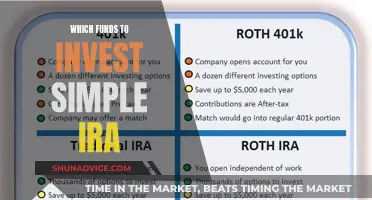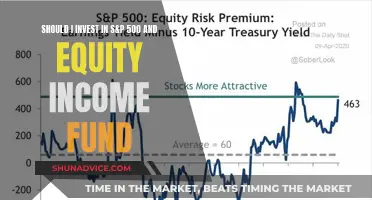
ELSS stands for Equity Linked Savings Scheme. It is a type of mutual fund that invests in equity shares, offering tax benefits under Section 80C of the Income Tax Act, 1961. ELSS funds are a great option for investors looking to grow their wealth while saving on taxes. With a short lock-in period of just 3 years, ELSS funds offer the potential for high returns, making them attractive for short-term investors. The minimum investment amount is typically low, starting from as little as Rs. 500, making it accessible to a wide range of investors. ELSS funds can be purchased offline or online, with the latter being a straightforward process involving registration and payment through net banking. Before investing, it's important to consider factors such as investment horizon, returns, and risk tolerance to ensure alignment with your financial goals.
| Characteristics | Values |
|---|---|
| Type of scheme | Equity Linked Savings Scheme (ELSS) |
| Type of fund | Mutual fund |
| Tax benefits | Up to Rs 1.5 lakh per annum under Section 80C of the Income Tax Act, 1961 |
| Investment options | Lump sum or Systematic Investment Plan (SIP) |
| Minimum investment amount | Rs 500 |
| Lock-in period | 3 years |
| Returns | 10-12% in the long run |
| Risk | High |
What You'll Learn

ELSS Funds: Tax Benefits and Wealth Creation
ELSS stands for Equity Linked Savings Scheme. ELSS funds are tax-saving mutual funds that combine the benefits of equity investments with tax deductions. ELSS funds have a minimum lock-in period of 3 years, offering the potential for high returns and tax savings, making them a popular choice for long-term investors.
Tax Benefits of ELSS Funds
ELSS funds offer tax deductions of up to Rs. 1,50,000 per year under Section 80C of the Income Tax Act, 1961. This helps investors save up to Rs. 46,800 per year in taxes. The lock-in period of 3 years is the shortest among all tax-saving investments, and ELSS funds have the potential to offer the highest returns.
Wealth Creation with ELSS Funds
ELSS funds invest a large portion of their corpus into equity or equity-related instruments. They offer diversification by investing across different market capitalizations, themes, and sectors. ELSS funds have generated average returns of 15% in the long term, with the potential for even higher returns over a longer investment horizon.
How to Invest in ELSS Funds
There are several ways to invest in ELSS funds, including online mutual fund investment platforms and through an existing demat account. Investors can choose between the lump sum and SIP (systematic investment plan) routes, with the latter being a more popular option due to its regularity and discipline. The minimum investment amount for ELSS funds is as low as Rs. 500, making them accessible to a wide range of investors.
Comparison with Other Tax-Saving Instruments
ELSS funds offer several advantages over other tax-saving instruments such as Public Provident Fund (PPF), National Savings Certificate (NSC), and tax-saving fixed deposits. ELSS funds have the shortest lock-in period of 3 years, offer higher returns, and provide better liquidity compared to traditional tax-saving options.
Obtaining Your Mutual Fund Investment Statement: A Guide
You may want to see also

ELSS vs Other Tax-Saving Instruments
Overview
ELSS (Equity-Linked Savings Scheme) funds are becoming an increasingly popular choice for investors, especially working professionals, due to their tax-saving benefits. However, it is important to compare ELSS with other traditional tax-saving instruments to make an informed decision. This section will outline the key differences between ELSS and other tax-saving options to help you understand why ELSS is often considered a superior choice for investors.
Lock-in Periods
One of the most significant advantages of ELSS funds is their short lock-in periods. With a mandatory lock-in period of only three years, ELSS funds offer the shortest commitment among all tax-saving investments. This is in contrast to other options such as tax-saving fixed deposits (FDs) with a five-year lock-in period, Public Provident Fund (PPF) with a 15-year lock-in period, and National Savings Certificate (NSC) with a five-year lock-in period. The short lock-in period of ELSS funds provides investors with greater flexibility and quicker access to their investments.
Investment Amounts
ELSS funds offer investors the option to start with a relatively small investment amount. With ELSS, you can begin investing with as little as Rs. 500 per month through a Systematic Investment Plan (SIP). This makes ELSS funds more accessible to a wider range of investors, especially those who may not have a large sum to invest upfront. In comparison, most other tax-saving options under Section 80C require a lump-sum investment, which can be a barrier for some individuals.
Returns and Equity Exposure
ELSS funds stand out from other tax-saving instruments due to their potential for higher returns. As ELSS funds are equity-oriented, they offer investors the opportunity to benefit from the stock market's performance. With a significant portion of their corpus invested in equity and equity-related products, ELSS funds have the potential to generate excellent returns over the long term. Among all the tax-saving instruments under Section 80C, ELSS funds offer the highest exposure to equity, making them a more attractive option for those seeking higher returns.
Ease of Investment
Investing in ELSS funds is a relatively simple and quick process. Many Asset Management Companies (AMCs) offer online portals that allow investors to initiate their investments within minutes. In contrast, other tax-saving options often involve complex paperwork and a lengthier setup process. The ease of initiating and tracking ELSS investments online makes it a more convenient choice for many investors.
Flexibility
ELSS funds provide investors with greater flexibility compared to other tax-saving instruments. For example, if an investor is unhappy with the performance of their ULIP fund, they are typically locked into investing in other funds offered by the same ULIP. However, with ELSS funds, investors have the freedom to move to another AMC's ELSS scheme or explore other funds without being tied to long-term deals. This flexibility is a significant advantage for those who want more control over their investment choices.
In conclusion, while there are various tax-saving instruments available, ELSS funds offer a combination of benefits that make them a preferred choice for many investors. The short lock-in period, potential for higher returns, flexibility, and ease of investment contribute to the growing popularity of ELSS funds over traditional tax-saving options. However, it is important to remember that investing in ELSS funds carries some risk, and it is always advisable to understand the risks and potential returns before making any investment decision.
Actively Managed Mutual Funds: Understanding Diverse Investments
You may want to see also

How to Invest in ELSS: Online and Offline
Equity Linked Savings Schemes (ELSS) are mutual fund investment schemes that help you save on income tax. ELSS funds invest a large percentage of their portfolio in equity and equity-related instruments, including listed shares and fixed-income securities.
ELSS funds have a compulsory lock-in period of three years, which is the shortest among all tax-saving instruments. There are no provisions for premature exit. The income you earn at the end of three years is known as Long Term Capital Gain (LTCG) and is taxed at 10%. This rule is applicable if the income is more than ₹1 lakh.
Online Mode of Investing
If you don't want to pay commission or brokerage fees, you can use online investment platforms such as Paisabazaar.com, where you can compare and choose from a wide range of funds. You will need to complete registration through an authorised channel, and you will receive a pre-filled bank mandate via email.
Offline Mode of Investing
If you are unsure about investing independently, you can choose to invest through a broker, although this will make you eligible for investments through regular plans with different returns and expenses. If you wish to invest independently offline, you must visit the nearest branch of the Asset Management Company (AMC) of your chosen fund and provide the following documents:
- Identity proof (Aadhar card)
- Passport-size photos (around 4-5)
- KYC documents (for KYC verification, such as Aadhaar or PAN)
- Post-dated cheques in favour of the mutual fund scheme with a duly filled application form/bank mandate forms
Factors to Consider Before Investing in ELSS
- Investment Horizon: Choose a tenure of at least five years. ELSS funds require a longer horizon to mitigate market volatility.
- Lock-in Period: You cannot redeem your holdings for three years, so plan your finances accordingly.
- Risk Appetite: ELSS is only suitable if you have an aggressive or moderate risk profile due to the inherent risks of investing in the equity market.
ELSS is a great option for salaried individuals who want to balance risk and return on their investment portfolio, with a short lock-in period and significant returns.
G Fund: A Safe and Secure Investment Option
You may want to see also

ELSS Funds: Investment Horizon, Returns, and Lock-In Period
Investment Horizon
ELSS funds are suitable for investors with a long-term investment horizon, typically more than five years. This is because ELSS funds are equity-oriented, and their performance depends on the underlying securities. Therefore, a longer investment horizon can help mitigate market volatility and provide higher returns compared to other tax-saving options.
Returns
ELSS funds do not provide guaranteed returns as they are dependent on the performance of the underlying securities. However, with an investment horizon of more than five years, ELSS funds have the potential to offer higher returns than other tax-saving investment options. Good ELSS funds can generate returns in the range of 10-12% in the long run, and some have even provided returns of over 14% in a five-year period.
Lock-In Period
ELSS funds have a mandatory lock-in period of three years, which is the shortest among all tax-saving investments under Section 80C of the Income Tax Act, 1961. This lock-in period is designed to encourage long-term investing and reduce emotional investing based on short-term market fluctuations. It also helps investors avoid market timing and promotes a disciplined investing approach. During the lock-in period, investors cannot redeem or withdraw their investments. After the lock-in period ends, the ELSS fund becomes an open-ended equity-oriented investment scheme, and investors can choose to redeem their investment or stay invested based on their financial goals.
Municipal Bond Investing: Vanguard Funds for Beginners
You may want to see also

ELSS Funds: Dividend and Growth Options
ELSS or Equity Linked Savings Schemes are mutual fund investment schemes that help investors save on income tax. They are also known as tax-saving funds.
Dividend and Growth Options
ELSS funds have both dividend and growth options. Investors get a lump sum on the expiry of the three-year lock-in period in growth schemes. On the other hand, in a dividend scheme, investors get a regular dividend income, whenever a dividend is declared by the fund, even during the lock-in period. For tax purposes, returns from an ELSS scheme are tax-free. You can claim up to Rs. 1 lakh of your ELSS investment as a deduction from your gross total income in a financial year under Sec 80C of the Income Tax Act.
How to Invest in ELSS
You can invest in ELSS the same way that you invest in any Mutual Fund. The easiest way is through an Online Investment Services Account. You can invest either as a lump sum or via the SIP (systematic investment plan) route. SIP ensures regularity and discipline and reduces the risk to capital. You can invest as little as INR 500 in an ELSS fund. While you can claim tax benefits only up to INR 1.5 lakh, you are free to invest as much as you like.
Mutual Funds: Investors Seek Diversification and Professional Management
You may want to see also







